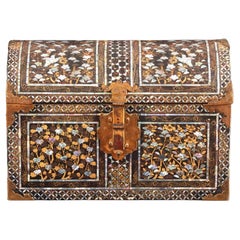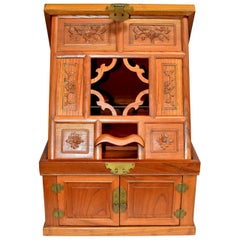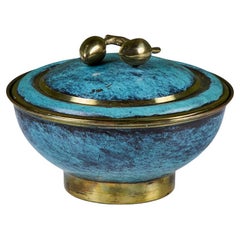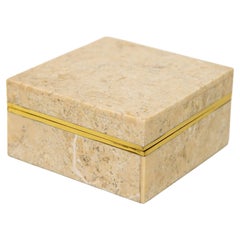Asian Boxes
to
194
1,258
179
7
83
421
754
186
289
202
132
32
16
28
12
5
19
21
15
38
13
117
49
44
34
34
19
7
4
3
2
2
1
1
682
617
286
221
134
985
330
7,164
1,745
1,670
1,669
1,444
Height
to
Width
to
1,444
1,408
1,432
57
34
31
16
13
Place of Origin: Asian
Superb Late 16th Century Signed Colonial Japanese Namban Export Lacquer Coffer
Located in Amsterdam, NL
Superb late 16th century signed colonial Japanese Namban export lacquer coffer
Momoyama period, late 16th/early 17th century, inscribed 'Arisato' on the bottom
H. 30.5 x W. 43...
Category
16th Century Antique Asian Boxes
Materials
Cedar, Lacquer
Chinese Solid Elm Jewelry Box with Carved Flowers
Located in Somis, CA
A beautiful, solid elm wood jewelry box with carved flowers and three full length drawers. The box opens to support the mirror stand. There are two positions for the mirror to be hel...
Category
Late 20th Century Asian Boxes
Materials
Brass
$275 Sale Price
50% Off
Hollywood Regency Patinated Brass and Copper Jewelry Box Made in Hong Kong
Located in San Diego, CA
Simple and elegant patinated brass and copper box, circa 1970s Perfect for jewelry, trinkets or playing cards. Stamped at the bottom Made in Hong ...
Category
20th Century Hollywood Regency Asian Boxes
Materials
Brass, Copper
$260 Sale Price
20% Off
Israeli Lidded Brass Bowl with Olive Knob
By Pal-Bell
Located in Los Angeles, CA
Pal-Bell round bowl with lid. This piece features a verdigris bronze bowl and lid with floral detailed knob with brass tips. Perfect for stashing keys, jewels or potpourri. An emboss...
Category
Mid-20th Century Mid-Century Modern Asian Boxes
Materials
Brass, Enamel
Maitland Smith Vintage Tessellated Stone Travertine Box 1970s
By Maitland Smith
Located in Moreno Valley, CA
Vintage Tessellated square shape decorative lidded marble box by Maitland Smith.
Measures: Square 4" x 4" x 2" H.
Maitland Smith 1970s tessellated travertine table...
Category
Late 20th Century Post-Modern Asian Boxes
Materials
Stone, Travertine, Marble, Brass
Hand-Carved Stone Jewelry Box Rajasthan, India
By Agra
Located in Moreno Valley, CA
Anglo Raj carved soap stone footed jewelry box..
Handcrafted decorative box with foliage design with soap stone natural jade like colors.
Lined with red velvet.
Very nice fine art...
Category
Mid-20th Century Anglo Raj Asian Boxes
Materials
Soapstone
Modern Box in Mother of Pearl with Polished Stainless Steel by R&Y Augousti
By R & Y Augousti
Located in West Hollywood, CA
The "Melting Box" by R&Y Augousti, crafted in polished stainless steel and adorned with intricate mother of pearl, is a striking piece that balances modern sophistication with artisa...
Category
21st Century and Contemporary Art Deco Asian Boxes
Materials
Stainless Steel
Chinese Early 20th Century Rattan Lunch Box with Tripartite Bamboo Handle
Located in Yonkers, NY
A Chinese antique rattan lunch basket from the early 20th century, with bamboo tripartite handle. Created in China during the early years of the 20th century, this lunch box captures...
Category
Early 20th Century Rustic Asian Boxes
Materials
Rattan, Bamboo
Indian Bone and Brass Decorative Dome Shaped Box or Stash Box
Located in Los Angeles, CA
A lovely dome shaped bone box from India. The box can be decorative or hold anything from rubber bands to 420. A compliment to cocktail tables, shelves, bedside or on an end table ...
Category
20th Century Asian Boxes
Materials
Brass
$200 Sale Price
20% Off
Silver Cigarette Case of Taj Mahal
Located in Hamilton, Ontario
Silver cigarette case of Taj Mahal.
Category
20th Century Asian Boxes
Materials
Silver
Japanese Kazaribako Glass Box Rare Hagoromo Kyohei Fujita
By Kyohei Fujita
Located in Atlanta, GA
A brilliant Kazaribako "Ornamented Box" made of glass by Japanese artist Kyohei Fujita (1921-2004) circa 1990s. The hand-blown green glass box featur...
Category
1990s Modern Asian Boxes
Materials
Silver
Chinese Canton Enamel Lobed Round Box, Qianlong Mark, Late Qing Dynasty, China
Located in Austin, TX
A well painted Chinese Canton enamel lobed round box and cover featuring the Eight Immortals, with a Qianlong mark to the underside, late Qing Dynasty, circa 1900, China
The deligh...
Category
Early 1900s Qing Antique Asian Boxes
Materials
Copper, Enamel
Qing Dynasty Hinged Box with Brass Hardware and Weathered Patina
Located in Yonkers, NY
A Qing Dynasty period hinged wooden box from the 19th century with brass hardware and nicely weathered patina. Crafted during the Qing Dynasty in the 19th century, this wooden box ca...
Category
19th Century Qing Antique Asian Boxes
Materials
Brass
Indian Inlaid Marble Box Floral Agate and Precious Stones
Located in Tampa, FL
A beautifully crafted vintage marble box from India, dating to the 1940s–1950s. The surface is intricately inlaid with agate and other precious stones, forming an elegant floral patt...
Category
1940s Vintage Asian Boxes
Materials
Multi-gemstone, Marble
Antique 19th Century Indian Kutch Solid Silver Cigarette Case c.1890
Located in Royal Tunbridge Wells, Kent
Antique 19th Century Indian Kutch solid silver cigarette case of heavy gauge, featuring intricate floral repoussé work on a matted background. The rectangular case has engraved edges...
Category
19th Century Other Antique Asian Boxes
Materials
Silver
JAPAN Meiji Period 1890 Tebako Desk Box Made In Precious Woods, Bronze & Gold
Located in Miami, FL
Presentation Tebako box from the Japanese Meiji period (1868-1912).
Beautiful decorative presentation Tebako desk box from the Japanese Imperial Meiji period, circa 1880. This box h...
Category
1890s Meiji Antique Asian Boxes
Materials
Gold, Bronze
$3,198 Sale Price
20% Off
Set of 3 Boxes in Black Shagreen and Bronze Patina Brass by R&Y Augousti
By R & Y Augousti
Located in West Hollywood, CA
This sleek set of 3 Desk Boxes by R&Y Augousti exemplifies the perfect balance between modern elegance and timeless luxury. Crafted in black shagreen with a curved top, each box is e...
Category
21st Century and Contemporary Art Deco Asian Boxes
Materials
Brass
Set of 2 Boxes in White Shagreen with Bronze Patina Brass Details by Kifu Paris
By Kifu Augousti
Located in West Hollywood, CA
This exquisite set of two boxes by Kifu Paris showcases the luxurious craftsmanship and meticulous attention to detail that the brand is renowned for. Handcrafted in white shagreen, ...
Category
21st Century and Contemporary Art Deco Asian Boxes
Materials
Brass
Japanese Lacquer Incense Box, Kogo, Momoyama or Edo Period, 16th/17th Century
Located in Austin, TX
A wonderful Japanese lacquer incense box, kogo, with a design of plovers in flight, late Momoyama or early Edo Period, circa 1600, Japan.
The small box, called a kogo, was used to s...
Category
Early 17th Century Edo Antique Asian Boxes
Materials
Gold, Pewter
Maitland Smith Tessellated Stone Box
By Maitland Smith
Located in North Hollywood, CA
Maitland Smith tessellated stone jewelry box in pink salmon color.
Category
1980s Hollywood Regency Vintage Asian Boxes
Materials
Stone
Qing Dynasty Square Box with Brass Lock and Distressed Lacquer Interior
Located in Yonkers, NY
A Chinese Qing Dynasty period square shaped box from the 19th century with brass lock, metal hardware and distressed lacquer interior. Born during the 19th century, this exquisite Qi...
Category
19th Century Qing Antique Asian Boxes
Materials
Brass
Vintage Boho Tessellated Stone Box
Located in West Palm Beach, FL
Discover the captivating allure of this vintage tessellated stone keepsake box, a remarkable piece that embodies bohemian elegance with a touch of sophisticated artistry. This exquis...
Category
Late 20th Century Hollywood Regency Asian Boxes
Materials
Stone, Brass
Chinese Vintage Black Lacquer Lidded Box with Hand-Painted Chinoiserie Décor
Located in Yonkers, NY
A Chinese vintage black lacquer lidded box from the mid 20th century, with hand-painted Chinoiserie décor. Created in China during the midcentury period, this black lacquer box showcases an oval lid adorned with a delicate Chinoiserie décor. Topped with a large handle, this black lacquer Chinoiserie box...
Category
Mid-20th Century Asian Boxes
Materials
Wood
Small Vintage Lidded Treen, Japanese, Mahogany, Spice, Jewellery Box, Circa 1950
Located in Hele, Devon, GB
This is a small vintage lidded treen. A Japanese, mahogany spice or jewellery box, dating to the mid 20th century, circa 1950.
Great colour and delight...
Category
Mid-20th Century Asian Boxes
Materials
Mahogany
Set of 2 Boxes in Black Shagreen with Bronze Patina Brass Details by Kifu Paris
By Kifu Augousti
Located in West Hollywood, CA
This exquisite set of two boxes by Kifu Paris showcases the luxurious craftsmanship and meticulous attention to detail that the brand is renowned for. Handcrafted in black shagreen, ...
Category
21st Century and Contemporary Art Deco Asian Boxes
Materials
Brass
19th Century Chinese Hand Carved Meal Delivery and Lunch Box
Located in Pomona, CA
This Antique lacquered lunch box from Shan Xi, China has over 140 years history and still maintained very good condition. There are some traditional carving works on the two sides handle and shows the traditional style of Northern China's cultural. This antique lunch box...
Category
Late 19th Century Chinese Export Antique Asian Boxes
Materials
Wood
$231 Sale Price
40% Off
Vintage Enamel Green, Blue, Pink Red "Good Luck" Foo Dog and Frog Chinese Box
Located in North Miami, FL
This remarkable vintage Chinese "good luck" small box has pushed out enamel jumping and leaping frogs and foo dogs in beautiful colors. Greens, light blue, blues, red, pink, yellow, black are amongst the colors setting off an off-white enamel honeycomb patterned background. It is dimensional and textural. The bottom is polished copper and patinated metal connecting all the other parts of the box. The interior is wood. It is from the original very vintage condition. This dates from 1890s and is truly remarkable. The bottom has been newly polished but one cannot polished the other parts of the metal that has enamel. Looks like museum quality! Marked China on the bottom. This is a special box...
Category
1890s Rococo Revival Antique Asian Boxes
Materials
Copper, Enamel
$805 Sale Price
30% Off
Tessellated Stone Decorative Jewelry Box
By Maitland Smith
Located in North Hollywood, CA
Tessellated exotic stone decorative jewelry box with brass inlays and velvet interior attributed to Maitland Smith
Interior of the box is 6" x 4" x 5.5" deep.
Category
1980s Hollywood Regency Vintage Asian Boxes
Materials
Stone
$1,000 Sale Price
20% Off
Set of 3 Quilted Boxes in White Shagreen with Bronze Patina Brass by Kifu Paris
By Kifu Augousti
Located in West Hollywood, CA
The Coco box collection by Kifu Paris exemplifies luxury through its intricate design and meticulous craftsmanship. This set of three quilted boxes in black shagreen, framed with a b...
Category
21st Century and Contemporary Art Deco Asian Boxes
Materials
Brass
Jewelry Box in Exotic Tigers Eye
By Maitland Smith
Located in North Hollywood, CA
Decorative jewelry box in tessellated exotic tigers eye with velvet interior.
Category
1980s Hollywood Regency Vintage Asian Boxes
Materials
Precious Stone
19th Century Chinese Gold Lacquer Tea Caddy
Located in Brea, CA
19th century Chinese gold lacquer tea caddy container from the Qing Dynasty. Unique shape, hard to find.
Category
19th Century Qing Antique Asian Boxes
Materials
Lacquer
Small Oval Chinoiserie Painted Ceramic and Metal Trinket Box with Mirror Lid
Located in Oklahoma City, OK
Bring a little chinoiserie to a vanity, side table, or coffee table. This pretty oval box is created from metal and has a hand painted and glazed ceramic top. The metal surrounds the...
Category
20th Century Chinoiserie Asian Boxes
Materials
Metal
$262 Sale Price
25% Off
1870s Antique Chinese Export Silver Card Case
Located in Jesmond, Newcastle Upon Tyne
An exceptional, fine and impressive antique Chinese Export Silver card case; part of our diverse Asian silverware collection
The anterior surface of this rare Chinese silver card case is ornamented with chased oriental figures amidst bamboo and foliate designs, accented with a fenced area and simplified structures, all on a matte background.
The ornamentation incorporates a vacant shield shaped cartouche.
The posterior surface of this silver card case is embellished with an exceptional chased decorated segmented iconic Chinese dragon design amidst clouds, also all on a matte background.
The rounded sides of this antique silver cigarette case...
Category
1870s Antique Asian Boxes
Materials
Silver
19th Century Middle Eastern Brass-Mounted Domed Teak Wood Box
Located in Middleburg, VA
An extraordinary 19th-century Middle Eastern domed casket, hand-carved from a single block of richly grained teak wood and mounted with pierced and hand-hammered brass hardware. This...
Category
Mid-19th Century Moorish Antique Asian Boxes
Materials
Metal, Brass
Middle Eastern Moorish Handcrafted Mosaic Decorative Trinket Box
Located in Moreno Valley, CA
Exquisite handcrafted Middle Eastern mosaic marquetry inlaid walnut wood box.
vintage small trinket box intricately decorated with Moorish motif des...
Category
Mid-20th Century Moorish Asian Boxes
Materials
Shell, Mother-of-Pearl, Fruitwood
Japanese Edo Period Igarashi School Long Lacquer Box, Tanzaku-Bako
Located in Austin, TX
A stunning Japanese Edo period lacquer tanzakubako, box for poem cards, late 18th-early 19th century, Edo Period, Japan.
Attributed to the Igarashi School, this box is masterfully ...
Category
Early 19th Century Edo Antique Asian Boxes
Materials
Mother-of-Pearl, Lacquer
Fine Cloisonné Enamel Silver Pill Box
Located in Worcester, GB
Fine Cloisonné Enamel Silver Pill Box
A finely crafted kidney-shaped sterling silver pill box, delicately enamelled throughout in vibrant shades of cobalt blue, turquoise, burgundy...
Category
Mid-20th Century Asian Boxes
Materials
Sterling Silver, Enamel
Set of 3 Curved Top Boxes in Black Oak by R&Y Augousti
By R & Y Augousti
Located in West Hollywood, CA
Experience the captivating design of R&Y Augousti's set of three curved top boxes, where clean lines meet the soft curvature of meticulously crafted white oak. Each box is a harmonio...
Category
21st Century and Contemporary Art Deco Asian Boxes
Materials
Wood, Oak
Anglo-Raj Marble Inlay Box Pietra Dura Made in India
Located in Fort Washington, MD
Anglo Raj inlaid marble pietra dura decorative box
This handmade marble decorative box is inlaid with semi precious stones, this type of design is the same art that you see in the Taj Mahal.
Very nice fine pietra dura art...
Category
Mid-20th Century Asian Boxes
Materials
Marble
Antique Japanese Lacquered Incense Box Kobako in Kodaiji Style
Located in Atlanta, GA
An antique lacquered small box that was likely used to contain incense powder (it is called Kobako in Japanese), circa early to mid-19th century of the Edo...
Category
19th Century Edo Antique Asian Boxes
Materials
Wood, Lacquer
Antique Chinese Export Silver Cigarette Case
By Zee Wo
Located in Jesmond, Newcastle Upon Tyne
A fine and impressive antique Chinese Export Silver cigarette / card case; part of our diverse Asian silverware collection.
This fine antique Chinese Export Silver (CES) cigarette/card case has a plain rectangular form with rounded corners.
The anterior cover is embellished with an embossed and chased decorated iconic Chinese dragon design amidst clouds, on a matte background, incorporating a shield shaped vacant cartouche.
The posterior cover is ornamented with traditional embossed and chased plum blossom foliate and floral decoration, also on a matte background.
The rounded sides of this antique silver cigarette case...
Category
Early 1900s Antique Asian Boxes
Materials
Silver
Anglo Raj Hand Painted Jewellery Wood Box 1920s
Located in Moreno Valley, CA
1920s Hand Painted East Indian Decorative Box.
An antique Rajasthani Indian hand painted wood box, early 20th century.
The box is handcrafted of wood and feature a hinged lid that can be opened and closed to access the contents inside.
Hand painted colorful Indian box with lid depicting human figures and flowers.
Style: Anglo Raj, Paint, Wood, Hand-Crafted
Place of Origin: India.
Anglo Raj Vintage Wooden Box Hand Painted Indian Chest Trinket 1920s.
Large Trinket Box Folk Art Hand Painted Colorful Asian Jewellery Chest...
Category
Early 20th Century Anglo Raj Asian Boxes
Materials
Wood
Maitland Smith Post Modern Zebra Hide Box 1980's
By Maitland Smith
Located in Moreno Valley, CA
Large Post Modern 1980s Maitland Smith decorative box made of a square wood bottom covered in brown leather and top lid covered with zebra hide with a round polished brass and hyde p...
Category
Late 20th Century British Colonial Asian Boxes
Materials
Leather, Zebra Hide
Antique Chinoiserie Painted Wood Jewel Box
Located in New Orleans, LA
This handsome painted jewel box is a pleasure. The interior has been refitted.
Category
Late 19th Century Antique Asian Boxes
Materials
Wood
Chinese White Brass Happiness Brazier, c. 1850
Located in Chicago, IL
Filled with burning coals, this petite 19th-century brass brazier once warmed the hands of a well-to-do person on a cold winter's night in northern China. The brazier is crafted of white brass in a rectangular form, complete with a hinged handle and an intricately pierced lid with a chrysanthemum pattern. The exterior is etched with a pattern of golden coins...
Category
Mid-19th Century Qing Antique Asian Boxes
Materials
Brass
Pen shell Pyramid Box attributed to Maitland Smith
By Maitland Smith
Located in Winnetka, IL
A pyramid shaped box having 4 graduating drawers with brass ball knobs . Made of polished pen shell which is a material that the manufacturer Maitland Smith often used. All sitting u...
Category
Late 20th Century Post-Modern Asian Boxes
Materials
Brass
19th Century Chinese Lacquer Tea Caddy
Located in Brea, CA
Middle 19th century Chinese Export double lacquer tea caddy on stand from the Qing dynasty. octagonal form with hinged lid ,divided interior with me...
Category
19th Century Qing Antique Asian Boxes
Materials
Lacquer
Japanese Red Enamel box
Located in Winnetka, IL
This is a rare enamel red box signed s. Inaba Kyoto . The picture on top is of three birds flying
Enamel is all intact and in great condition
Beautiful box to add to any collection!
Category
20th Century Asian Boxes
Materials
Enamel
Early 20th Century Antique Tibetan Silver Turquoise Ghau Prayer Box
Located in Pomona, CA
Ghau is a small prayer box worn as pendant by Buddhists as portable shrines which can be pray by prayer during their travel. This Ghau prayer box (travel Buddha...
Category
Early 20th Century Chinese Export Asian Boxes
Materials
Silver
$275 Sale Price
30% Off
RUSSIAN 1860 Antique Pietra Dura Dog Gold Oval Pill Box In Solid 14Kt Yellow
Located in Miami, FL
Antique gold box with Pietra-Dura panel.
This is a beautiful antique oval box created in Russia back in the 1860. The box has been crafted in solid yellow gold of 14 karats (56 zolo...
Category
1860s Early Victorian Antique Asian Boxes
Materials
Multi-gemstone, Gold
$7,160 Sale Price
20% Off
Antique Imperial Russian Lukutin Racing Winter Troika Lacquer Jewelry Casket Box
Located in New York, NY
Fine antique Imperial Russian lacquer Racing Winter Troika jewelry casket by the Lukutin Workshops
19th Century
In exceptionally fine condition with original key
The Russian lacquerw...
Category
19th Century Antique Asian Boxes
Materials
Lacquer
Erotic Chinese Baitong Opium Box, c. 1850
Located in Chicago, IL
A petite white brass (baitong) canister once used to store a smoker's personal supply of opium paste. Dated to the 19th-century, the box is an example of Qing-dynasty erotica, incorp...
Category
Mid-19th Century Qing Antique Asian Boxes
Materials
Brass
Unique 17th Century Miniature Japanese Namban Lacquer Miniature Dollhouse Chest
Located in Amsterdam, NL
A unique and exceptional Japanese miniature or dollhouse export lacquered chest
Kyoto, circa 1620-1640
The chest of rectangular shape with a domed lid, decorated in Transition-style, in gold hiramaki-e on a black background within reserved lobed cartouches decorated with landscapes animated with birds and rabbits, on a shagreen or samegawa background. The borders are decorated with geometric friezes, the box with gilt-copper mounts, the interior decorated in red lacquer.
Measures: H 9.2 x W 14.5 x D 7.2 cm
This miniature is of exceptional quality and a perfect copy of the famous large size Transition-style coffers. It was most likely ordered by a Dutch lady for her dollhouse (poppenhuis), like the famous Petronella Oortman (1656-1716) doll-house, which is now one of the highlights in the collection of the Rijksmuseum Amsterdam, or Petronella Oortmans-de la Court’s (1624-1707) dollhouse in the collection of the Centraal Museum Utrecht. Sara Rothé of Amsterdam in 1743 ordered a miniature black lacquered ivory tripod table with gold chinoiserie decoration by Jurriaan Buttner (Monika Kopplin, European Lacquer, 2010, p. 56).
Other Japanned dollhouse...
Category
17th Century Edo Antique Asian Boxes
Materials
Shagreen, Cypress
Mystic Elegance: Siberian Charoite Keepsake Box
Located in New York, NY
This exquisite Charoite Box (3.5" x 4.25") is crafted from a rare and mesmerizing purple-hued mineral found exclusively in Siberia, Russia. The swirling patterns of deep violet, lave...
Category
21st Century and Contemporary Asian Boxes
Materials
Stone
A Japanese Meiji Period Black Lacquer Hokai Lidded Box with Brass Mounts
Located in San Francisco, CA
this large ribbed and cylindrical Japanese shell-game box with domed lid decorated overall with Maki-e (gold lacquered) foliate wreaths and stylized flower heads and incised brass mounts; raised on four splayed supports.
Hokai boxes...
Category
Late 19th Century Meiji Antique Asian Boxes
Materials
Lacquer
Set of 2 Boxes in White Shagreen with Mother of Pearl and Bronze Patina Brass by
By R & Y Augousti
Located in West Hollywood, CA
The “Peacock Box” set by R&Y Augousti is a true masterpiece of modern luxury, where organic form meets exceptional craftsmanship. The distinctive, fluid shapes of these boxes create ...
Category
21st Century and Contemporary Art Deco Asian Boxes
Materials
Brass
Persian Box Khatam Kari Footed Wooden Round Jewelry Vanity Trinket Moorish Box
Located in Moreno Valley, CA
Late 19th c. early 20th c. Persian Footed Wooden Round Jewelry Box.
Antique rare in round shape large Persian wooden box with marquetry called "Sadeli" or "Khatam Kari" with exquisit...
Category
Late 20th Century Islamic Asian Boxes
Materials
Brass
Japanese Maki-e Lacquerware Portable Picnic Set Sagejubako
Located in Atlanta, GA
Sagejubako is a portable picnic set that became popular in the early Edo period when an additional meal was added between breakfast and dinner. It normally consists of a carry case w...
Category
19th Century Japonisme Antique Asian Boxes
Materials
Lacquer
Antique Chinese Carved Wooden Gold and Red Decorative Box
Located in Queens, NY
Antique Chinese circular wooden box with carved top character design and carved geometric foot, painted in gold and red with a fitted lid and fine black painted border pattern.
Category
20th Century Chinese Export Asian Boxes
Materials
Wood
Persimmon Box in Cream Lacquer by Robert Kuo, Limited Edition
By Robert Kuo
Located in Los Angeles, CA
Persimmon box
Black lacquer
Hand repousse
Copper base
Limited Edition
Lacquer is a laborious and time-consuming process. After it is tapped from the
trees, lacquer needs to b...
Category
21st Century and Contemporary Asian Boxes
Materials
Copper
Still Thinking About These?
All Recently ViewedMore Ways To Browse
Ballot Box
Bronze Music Box
Campaign Writing Box
Carved Jade Box
Chinoiserie Paper Mache
Cranberry Box
Erhard And Sohne
Frog Box
Italian Leather Gold Embossed
Large Japanese Lacquer Box
Malachite Trinket
Marble India Pietra Dura
Micromosaic Box
Moorish Mother Of Pearl Box
Moroccan Bottle
Mother Of Pearl Sewing
Painted Bentwood Box
Rhinoceros Beetle





